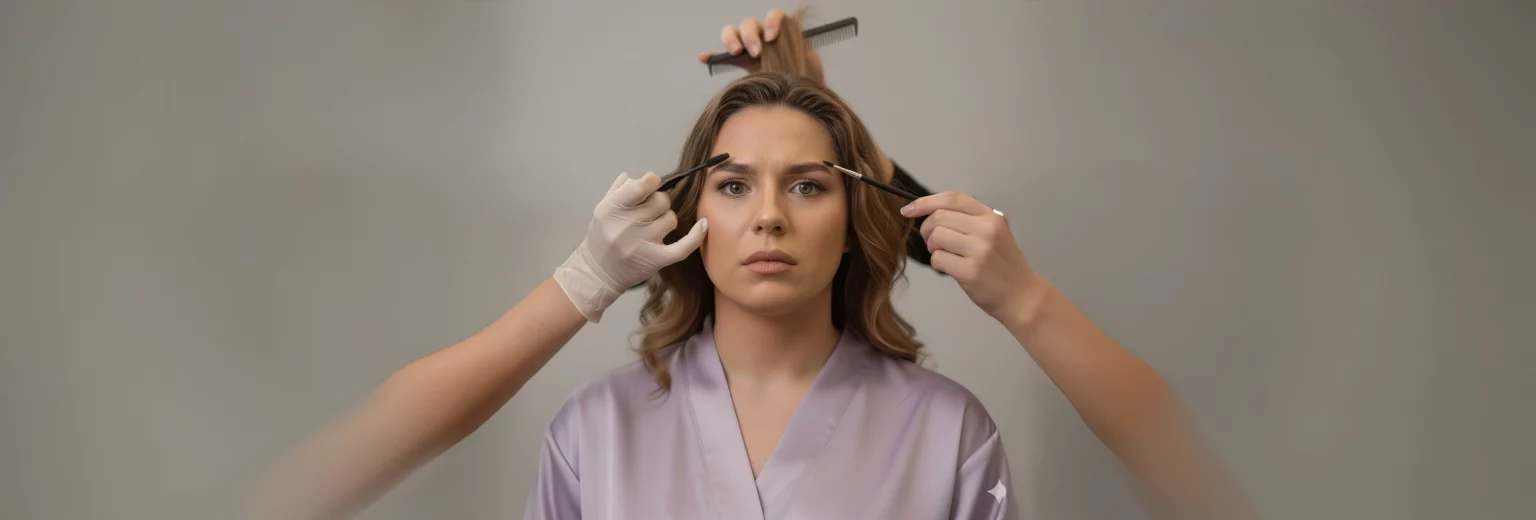The Importance of Styling in Gender Perception

When we talk about gender perception, the first thing that comes to our minds is Facial Gender Affirming Surgeries, but what if I told you other aspects influence how people read you? Hair, lashes, brows, skin… – all of these details impact how society perceives you. Is there a reason behind it?
Let’s explore together what details society considers masculine or feminine in this article.
How Society Reads Femininity and Masculinity
From a young age, we’re taught to associate certain styles with gender. Society tends to code long, healthy, shiny hair, curled lashes, smooth skin, and shaped thin brows as feminine. Meanwhile, short haircuts, fuller brows, natural lashes, and textured skin often get read as masculine.
These aren’t biological truths; they’re cultural stories. These change depending on time, place, and trend. In the 1920s, women with short bobs were seen as rebellious and ultra-feminine; in other eras, the same haircut would be considered masculine. Fashion, beauty, and styling evolve – and so do the stereotypes attached to them.
Understanding these associations helps explain why many people feel pressure to look a certain way to be perceived as belonging to one gender or another. But it also highlights how fragile and arbitrary these rules are.
Your Hair as A Symbol of Gender Expression
Hair has always been far more than a biological feature. In every society, it functions as a powerful symbol of identity, culture, and belonging. It is one of the first things we notice about someone, and because of that, it has long been used as a marker of who we are and how we are perceived. From the length and texture to the style and color, hair communicates messages about personality, age, gender, and even social status.
Throughout history, hair has been tied to ideas of beauty and gender. Long, shiny, and carefully styled hair has often been associated with femininity, while short and practical cuts are seen as masculine. These norms have shaped how people, especially women, are expected to present themselves, often placing more pressure on them to maintain, style, and modify their hair to meet societal standards. Although these rules are slowly changing, the way someone wears their hair still heavily influences whether they are read as feminine, masculine, or somewhere in between.
A hairstyle can affirm your gender identity, but it can also reinforce stereotypes if you feel forced into a look just to be recognized correctly. Something as simple as growing out bangs or shaving the sides can dramatically shift how strangers address or treat someone, which shows just how central hair is to gender perception.
What makes this especially significant is that these associations are not natural but cultural. Across history and geography, hairstyles have carried different meanings. In some cultures, men wore long hair as a symbol of strength, while in others, women shaved their heads as a sign of devotion. This fluidity highlights the fact that hair itself is neutral-what gives it gendered meaning is the social context.
At the end of the day, hair is just protein growing from our scalp, yet society has layered it with so much symbolism that it can influence how seriously we’re taken, whether we’re respected, and even how our identity is acknowledged.
Eyelashes as a Gender Marker
Eyelashes, like hair, carry a surprisingly powerful role in how people read gender, though their impact is subtler and often more psychological. They frame the eyes – the feature most associated with expression and emotion – and can drastically affect how “feminine” or “masculine” someone appears, even without conscious thought.
Long, thick, and curled eyelashes are culturally coded as feminine. They accentuate the eyes, creating a softer, more open appearance, which society often links to beauty, youth, and nurturing qualities. This is why mascara, lash lifts, and extensions are such common tools in feminine-presenting beauty routines; they amplify traits historically associated with femininity. On the other hand, shorter, sparser, or straight lashes are less highlighted in social perception and often read as more neutral or masculine, largely because societal norms have rarely emphasized men’s eyelashes in the same way.
Interestingly, this isn’t universal or fixed. Some people may associate dramatic lashes with glamour or “made-up” looks rather than natural femininity, which could influence perception differently depending on context. But generally, in Western beauty norms, lashes are a strong visual shorthand for femininity.
Like hair, the credibility of these norms is questionable. There’s nothing inherently feminine about long lashes, they are simply another physical trait society has assigned gendered meaning to. Yet, because of cultural expectations, people often feel pressure to modify them to meet gender norms, even though eyelashes themselves are neutral.
The Importance of Your Eyebrows
Though small, brows shape the face in powerful ways. The shape, thickness, and grooming of eyebrows can subtly signal femininity, masculinity, or androgyny, and small changes can make a big difference in how someone is perceived.
Traditionally, thinner, arched, and well-groomed eyebrows are culturally associated with femininity. They tend to create a lifted, open appearance that softens facial features and draws attention to the eyes, complementing other traits society links with a feminine look.
At the same time, thicker, straighter, and less sculpted eyebrows are often read as more masculine, giving a stronger or more angular frame to the face. This doesn’t mean one type of eyebrow is inherently gendered; these are purely social associations, but they are deeply ingrained, so they influence first impressions and gender perception heavily.
It’s interesting how much weight society places on something as small as eyebrows when it comes to reading gender. Yet anyone observing real faces knows this is clearly not true. Women with naturally full, bold eyebrows are still perceived as feminine, and men with softer brows can be read as masculine. These expectations reveal less about biology and more about the arbitrary rules society enforces to categorize people.
Skin and the Myth of Perfection
Smooth, glowing, “flawless” skin is often portrayed as the ultimate feminine ideal in the media. Meanwhile, rugged or textured skin is coded as masculine. This stereotype is reinforced by beauty industries that market skincare products almost exclusively to women, implying that caring for your skin is a feminine responsibility.
But skin is not gendered. It’s your body’s largest organ, protecting and renewing itself constantly. Genetics, hormones, lifestyle, and environment all affect how it looks. Whether you embrace skincare routines as a ritual of self-care or keep things minimal, neither choice makes you more or less feminine or masculine.
Makeup and Styling Rituals: Tools, Not Rules
Makeup, hairstyling, and grooming are often framed as requirements for femininity. Women are expected to spend more time and money on beauty rituals than men, reinforcing the stereotype that their value lies in appearance. For trans women, this pressure can feel even heavier, as passing or being read correctly is tied to safety, comfort, and recognition.
I like to see these rituals not as obligations, but as a form of art. Some people love the creativity of makeup, the satisfaction of styling hair, or the ritual of skincare. Others see them as chores, or simply unnecessary. Both perspectives are valid. What matters is choice – not compliance with someone else’s idea of gender.
Your Identity Is Not on the Surface
Yes, hair, lashes, eyebrows, and skin all play a role in how society perceives femininity and masculinity. Styling can influence how people see you – but it can never define who you are. Gender is not in the details of your appearance; it’s in your truth, your story, and your identity.
This article illustrates something key: gender perception is flexible and context-dependent. Society’s stereotypes are guidelines, not rules. People can read thick, full brows as feminine, especially when paired with other feminine cues like softer eyelashes, facial expression, or hairstyle. Conversely, thin, sharply arched brows won’t automatically make someone appear feminine if the other cues suggest masculinity.
At the end of the day, femininity and masculinity are social constructs. They are narratives society has created, and they shift constantly. What doesn’t shift is you – your identity, your worth, your uniqueness. Styling may change how the world perceives you, but only you get to define who you are.


